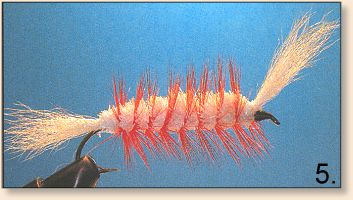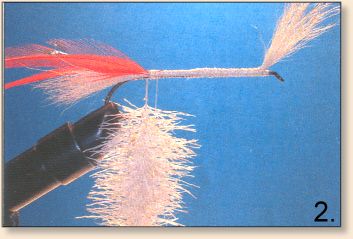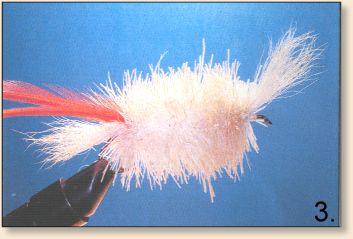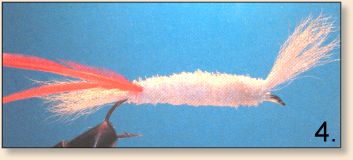The Hair Loop Bomber

By Sheldon Seale
Ask any Atlantic salmon anglers about their favourite
dry flies and high on the list will be bombers. These
spun deer hair floating flies account for a good proportion
of fly caught Atlantics. But it's not just the classy
Atlantic salmon which can be tempted by bombers; virtually
any fish that likes to grab creatures swimming on the surface
will hit a bomber. Bass, both largemouth and smallmouth,
are particularly susceptible to them.
Bombing for bass can be addictive and darn near heart
stopping! Essentially, bombers are a kind of slider lure
which has a subtle, quiet action, unlike noisy poppers
and divers. They are especially effective in those
heavily fished waters found in and around urban areas.
You know the ones - they get pounded all the time, but
hold good fish. Under these circumstances, the subtlety
of the bomber can often be very effective.
Bombers come in any size or colour combination you care to
make up. They usually incorporate a tail to help float the
hood bend, and often include a wind (which can be a single
or a divided) slanted out over the hook eye. Wing and tail
are usually made from calftail, but any similar material will
serve, including bucktail and squirrel tail.
The traditional way of making the body is by spinning and
packing deer hair, especially on a hook shank partially
covered with thread and the roots of tails and wings.
However, there is another way - the deer hair loop. This
method is a little more time consuming, but it's a useful
alternative for those fly fishers who have difficulty
spinning and packing deer ahir. It also makes tying hair
bodies on small flies, such as Irresistibles and Rat Faced
MCDougalls, on hooks as small as #14, as well as tiny bomber
for panfish possible.
Deer hair loops are made in the same way as dubbing loops,
and wound on like wool or chenille. You need to use a heavy
thread (minimum 3/0) and twist the hair in the loop until it
lools like a bottlebrush. The secret is to trim the tips from
the hair before you put it in and loop and to distribute the
hair evenly before you start twisting it. Once wound on, it
can be packed very tightly on the hook shank whether it's
covered with thread and/or wing/tail material.
Tying Notes

Step 1
Start your thread at the front and wrap back
to the bend. Select a small amount of calftail for the tail
and tie in. Tie down the butts along the top of the hook
shank.
Advance your thread to the front. Select a slightly larger
amount of calftail for the wing. Tie in with the tips pointed
out over the hook eye. Tie down the butts along the top of the
hook shank. If the butt ends of the tail and wing overlap, trim
out enough hair for them to just meet. Using several wraps of
thread at the eye, force up the wing to at least a 45° angle.
If you wish to split the wing, you can do this with a few "X"
wraps to seperate the wings and a couple of turns around the bases
of the wings to help the definition.

Step 2
At the back of the hook shank, tie in a large dubbing loop.
Cut deer hair from the skin, remove any underfur and trim
the tips off. Place the hair in the loop and distribute it
evenly along its length. The hair will be at right angles
to the thread. Put a dubbing twister in the loop and spin
it until a bottle-brush effect is achieved. The photo shows
what is required.

Step 3
Wrap the dubbing brush around the shank as if it were wool or
chenille. Take the first wrap behind the saddle hackle(s) and
brush the hair back before every wrap. Fill up the hook shank
with the dubbing brush. You may need 3 or 4 loops to complete
the fly depending on size and how tightly you pack the hair
back. To secure a loop, just tie off the thread with another
loop. The photo shows the fly after it has been completely
wrapped with the dubbing brushes.

Step 4
Once the hook shank is completely covered, tie off the white
thread. Remove the hook from the vice and trim the body to
a narrow, cigar shape being careful not to cut off the
saddle hackle(s). The photo shows the body after it has been
trimmed.

Step 5
Put the hook back in the vice and reattached the thread. Wind
the saddle hackles(s) forward in open wraps and tie off at the
front. Trim any excess hackle and tie off. Coat the exposed
thread with head cement and the fly is finished.
The same technique can be used for tying bugs, another
similar Atlantic salmon pattern, but tied on a shorter shank
hook.
Fishing Notes

Fish the bomber in and around cover. Cast it into a likely
spot and let it rest for a moment. Give it a twitch and
let it rest again. Move it slowly controlling the direction
with line minding (you would be amazed at how convoluted a
path you can follow by mending line). Use stout tippets
and be prepared for a take at any time. Apply floatant to
help keep it on the surface.
There's nothing more exciting than having a large bass blow
up a bomber just off the end of your rod just as you were
about to pick it up for another cast. It can be especially
heart stopping from a float tube, as you're so close to the
action. Largemouths like large offerings. Even #2/0 Bombers
are not too big for them, although I usually use a #2 (those
really big Bombers are hard to cast with a 6 or 7 weight).
Scale down for smallmouth - I usually fish #8s. You can even
incorpaorate a weed guard for those really heavy cover areas,
although the hackle does keep them reasonably weedless.
~ Sheldon Seale
Credits:
We thank the
Canadian Fly Fisher for re-print permission!
Our Man In Canada Archives
|







